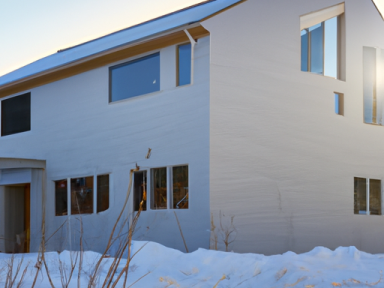
A guide on designing homes that naturally stay warm in winter and cool in summer
When it comes to designing your home, there is no better way to prepare for the unknown than by harnessing the power of passive solar design. In an unpredictable world where extreme weather events are becoming increasingly frequent, passive solar design is a crucial element in creating a home that can naturally stay warm in winter and cool in summer, all while reducing your reliance on external energy sources. So let’s dive into the principles and techniques of passive solar design that will help you create a resilient and self-reliant home.
1. Orientation is key
One of the most important considerations in passive solar design is the orientation of your home. By positioning your home to maximize exposure to the sun, you can capture the heat during the winter months and minimize direct sunlight during the summer months.
For those living in the northern hemisphere, orienting the longest side of your home to face south allows for optimal sun exposure. Conversely, for those in the southern hemisphere, facing north is most advantageous. This strategic positioning will ensure that your home receives the maximum benefit from passive solar heating.
2. The magic of thermal mass
Another key component of passive solar design is thermal mass. This involves using materials with high heat capacity, such as concrete, stone, or even water, to absorb and store heat during the day and release it slowly at night. This process helps regulate the temperature inside your home, keeping it comfortable year-round.
By incorporating thermal mass into your home’s design, you can create a more stable and energy-efficient living space. Consider using materials like concrete or stone for your floors, walls, or even as interior features.
3. Harnessing the power of insulation
Proper insulation is paramount when it comes to passive solar design. By minimizing heat loss in the winter and heat gain in the summer, you can create an environment that remains comfortable throughout the year.
Focus on sealing any air leaks and insulating your windows, doors, walls, and roof with high-quality insulation materials. This will help prevent drafts, reduce heat transfer, and ensure your home maintains a consistent temperature without relying heavily on artificial heating or cooling methods.
4. Ventilation for natural cooling
In addition to capturing the sun’s heat in the winter, passive solar design also emphasizes natural cooling strategies for the summer months. Proper ventilation is crucial in allowing hot air to escape and cool air to enter your home.
Strategically placed windows, skylights, or vents can help facilitate natural airflow. You can also utilize shading devices, such as awnings or deciduous trees, to block direct sunlight during the hottest parts of the day, keeping your home naturally cool and comfortable.
5. Embracing renewable energy sources
While passive solar design focuses on minimizing energy consumption, it’s important to consider incorporating renewable energy sources to further enhance the self-reliance of your home.
Consider installing solar panels on your roof to harness the power of the sun and generate electricity. This will not only provide a sustainable energy source but also reduce your reliance on the grid, making your home more resilient in case of power outages.
Conclusion
Designing a home that naturally stays warm in winter and cool in summer is not only a smart decision but also a necessary one in an increasingly uncertain world. By utilizing the principles of passive solar design, you can create a resilient and self-reliant living space that is comfortable year-round and reduces your dependence on external energy sources.
Remember, being prepared is not about succumbing to fear; it’s about taking action to ensure the safety and well-being of yourself and your loved ones. So start incorporating these passive solar design techniques into your home today and embrace the power of self-reliance.



GIPHY App Key not set. Please check settings